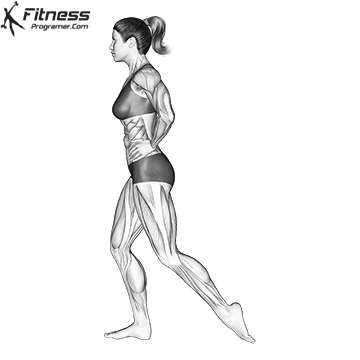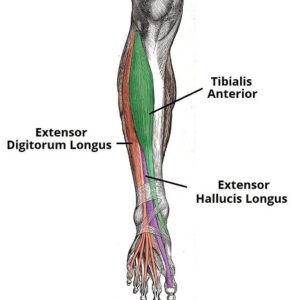Overview
The Toe Extensor Stretch is a static mobility and flexibility exercise that targets the toe extensor muscles, including the extensor digitorum longus and extensor hallucis longus, along with the tibialis anterior. This standing stretch is designed to reduce tightness on the top of the foot and front of the shin, areas commonly affected by running, jumping, or prolonged walking in restrictive footwear.
The stretch is simple, effective, and requires no equipment, making it ideal for use in cool-down routines, rehabilitation programs, and daily mobility practices.
How to Perform the Toe Extensor Stretch

Starting Position: Stand tall with feet hip-width apart.
Step Back: Extend one leg behind you and place the tops of your toes on the ground with the foot pointed downward.
Shift Weight Forward: Transfer your weight slightly onto the front leg, allowing the rear foot to press gently into the floor to create a stretch on the top of the foot and shin.
Hold the Position: Keep your torso upright, shoulders relaxed, and spine neutral while maintaining balance.
Duration: Hold the stretch for 20–30 seconds, breathing deeply and avoiding bouncing.
Switch Sides: Return to the starting position and repeat on the opposite foot.
Tips for Proper Form
Use a wall or chair for balance if needed, especially when new to the position.
Apply gentle pressure—the stretch should be felt along the top of the foot and shin, not the ankle joint.
Keep the foot aligned—avoid turning the toes in or out excessively.
Perform barefoot or in soft shoes for better foot contact and feedback.
Keep your posture upright to avoid shifting stress to the lower back.
Common Mistakes
Forcing the stretch: Excessive pressure may lead to ankle strain or discomfort.
Twisting the foot: Misalignment reduces stretch effectiveness and may irritate joints.
Holding breath: Breathing helps muscles relax and enhances stretch quality.
Bouncing or rocking: Can reduce stretch effectiveness and increase risk of strain.
Ignoring foot position: Make sure the toes are pointed and resting on the floor, not curled under.
Benefits of the Toe Extensor Stretch
Releases tightness in the toe extensors: Especially beneficial for runners and those with anterior shin tightness.
Improves foot and ankle flexibility: Enhances range of motion in the toes and dorsal ankle, supporting healthy gait patterns.
Reduces foot pain from overuse: Helpful for addressing tension caused by excessive dorsiflexion or tight footwear.
Supports injury prevention: Increases mobility in key foot muscles, helping prevent strains, shin splints, and tendon irritation.
Easy to perform anywhere: Requires no equipment and can be done in minimal space, ideal for travel or daily movement breaks.
Improves toe mobility: Contributes to more natural foot movement, which supports balance and lower body control.
Balances lower leg training: Complements calf raises and dorsiflexion drills by addressing the flexibility of opposing muscle groups.
How to Incorporate Into Your Routine
- For Runners and Athletes: Use after training to relieve tension in the foot and shin muscles caused by repeated dorsiflexion.
- For Daily Mobility: Perform 1–2 times per day if you wear tight shoes or feel foot/ankle stiffness after walking or standing.
- For Rehab and Recovery: Recommended in lower limb recovery routines for shin splints, ankle stiffness, or postural foot issues.
- For Warm-Up: Use gently before jumping, sprinting, or dynamic footwork to prepare the ankle complex.
- For Yoga or Functional Fitness: Include in a flexibility sequence for lower body balance and neuromuscular awareness.
Muscles Worked

Frequently Asked Questions
Should I feel this stretch in my ankle or my toes?
You should feel a gentle stretch along the top of the foot and shin, especially through the toes and lower shin.
How long should I hold the stretch?
20–30 seconds per side is sufficient. Repeat 1–2 times for optimal effect.
Is it safe for people with foot pain?
Yes, but proceed gently. If you have plantar fasciitis or joint issues, consult a medical professional before performing.
Can I do this stretch with shoes on?
You can, but barefoot or socks-only gives better contact and control.
When is the best time to do this stretch?
Post-workout, during cooldowns, or any time you feel tension in the top of your feet or shins.
